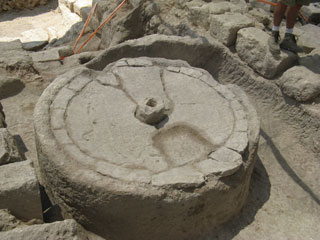A unique and impressive complex for producing oil that dates to the Byzantine period, which is also one of the largest uncovered in the country so far, was discovered recently during trial excavations conducted by the Israel Antiquities Authority in Moshav Ahihud, in the Western Galilee. The excavations are being carried out as part of a development plan to enlarge the village.
According to Michael Cohen, the excavation director on behalf of the Israel Antiquities Authority, “a mighty conflagration occurred in the olive press in the seventh century CE. Remains of the blaze, which are quite evident on the walls of the building, destroyed the structure and negated the installation’s use”. This event “preserved” many of the details of the olive press.
In the middle of the building a central crushing mill (a large round stone) was uncovered upon which a millstone (referred to as a memel) was placed. It was customary to harness an animal to the axle of the millstone which would turn the stone and thereby crush the olives.
After crushing and breaking them, the olive pulp was brought for pressing in aqalim (baskets woven of coarse fabric or ropes). The aqalim were squeezed in a press and the olive oil was extracted as a result of this action. The baskets served as a filter whereby the liquid dripped out leaving the pits and pulp waste behind in the baskets.
Three screw type press beds and a stone weight that was originally connected to the end of a. beam were revealed at the site.

Aerial photograpy by "SkyView" ltd
Along side the press beds collecting vats, settling pits and other pools that were used to separate the oil from the watery lees (the non-oily liquid that is also expressed from the olives) were exposed.
Two built containers that were used to store the oil were exposed next to the oil production installations. The containers have a combined capacity of approximately 20,000 liters. The containers were paved with mosaic floors and treated with plaster. The top of the wall that separates the two containers was paved with a mosaic, part of which is adorned with a geometric decoration and part bears an inscription that has not yet been deciphered.
This very formidable and rare olive press and the inscription on the mosaic floor suggest that the complex was not built at the initiative of a local individual.
Among the artifacts recovered during the course of the excavations are numerous remains of roof tiles, a marble colonnette, two fragments of a marble chancel screen, many stem lamps, an imported plate with a figure carrying a child carved in its base and a bronze chain used to suspend a lamp. These items indicate that a church stood nearby and therefore the excavators believe that the olive press could be situated inside a Byzantine monastery.
The occupation ot the place continued to exist above the remains of the olive press throughout the early Islamic period.
In addition to this olive press in it's vicinity other olive presses and wine presses were also found .
The location of the site, on a western spur of the Galilee along the border of the Akko coastal plain, 9 kilometers east of Akko, suggests that this was an agricultural production center that served the farming hinterland of the principal city of Akko – Ptolemais.
Possibilities as to how to conserve and present this special find are currently being examined in cooperation with the residents of the village.
Additional Articles ...